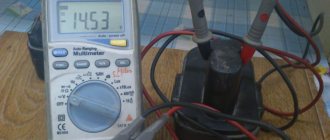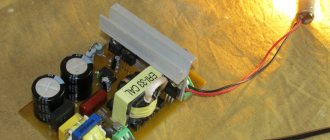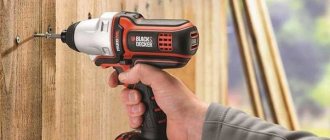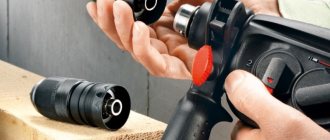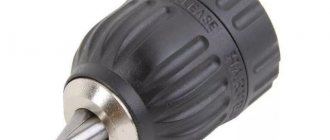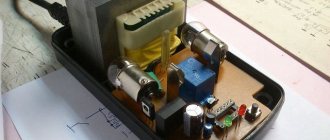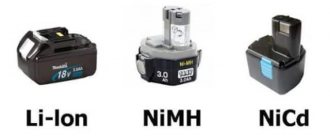DC motor
made in the form of a cylinder, in which permanent magnets are located in a circle inside the body. The motor armature is located on support bushings made of brass. The armature itself is made of electrical steel with high magnetic permeability. Windings of insulated copper wire are placed in the grooves of the armature. After an equal number of turns, the winding has access to the collector plates. The drive gear (sun gear) is pressed onto the armature shaft. The motor brushes touch the commutator plates on the “tail” of the armature. For reliable contact, the brushes are spring-loaded, while being isolated from the motor housing. According to the screwdriver circuit, voltage is supplied only to the brushes. If you change the polarity of the voltage supplied to the motor brushes, the direction of rotation will also change.
Planetary reductor
The screwdriver is made in a separate housing. The gearbox includes the following elements: ring gear, sun gear (pressed onto the armature shaft), satellites and carrier. Gearbox parts can be made of both plastic and metal. For a more complete picture of the operation of the gearbox, it is necessary to clarify the location of the individual parts.
A ring gear is a cylinder, inside of which there are teeth along the entire circumference along which the satellites move during operation. The satellites are installed on the carrier pins. Between the satellites of the first carrier, the engine drive gear (the first sun gear) comes in. The first carrier, on the opposite side of the satellites, has a drive gear (the second sun gear), which, when assembled, fits between the satellites of the second carrier.
If the gearbox is two-stage, the second carrier is rigidly connected to the shaft on which the cartridge is mounted. Thus, you get a kind of “sandwich” of two carriers with satellites. This "sandwich" is located inside the ring gear.
The ring gear is rigidly attached to the housing using protrusions on its end or sides. The protrusions rest against protruding balls, spring-loaded by an elastic ring around the entire circumference. The ring, in turn, is spring-loaded by the load limiting mechanism spring. The spring force may vary depending on the position of the load regulator.
The operation of the gearbox is as follows: the engine sun gear rotates the satellites in a circle around the ring gear, and accordingly the carrier rotates at a lower speed than the engine speed. The first carrier transmits torque through its sun gear to the second trio of satellites, which also rotate around the ring gear, which means the speed of the second carrier decreases even more. The second carrier, as mentioned above, is connected to the cartridge shaft. This happens in a two-stage gearbox. There are models of screwdrivers with three-stage gearboxes; they have another planetary mechanism inserted into the gearbox. At the end of the article there is a video showing the operation of a planetary gearbox.
There are models of screwdrivers with a conventional gearbox.
For convenience during work, some screwdrivers have two-speed gearboxes. The first speed is intended for tightening screws (0-450 rpm and increased torque), and the second for drilling holes (0-1400 rpm).
When rotating the chuck under load, there comes a time when more force is required to complete the job, for example, the last stage of tightening a screw, or when it is necessary to limit the force. The load regulator comes into operation. The force of the regulator spring is not enough to hold the ring gear and it “breaks off” from the balls. It turns out that the engine begins to rotate the ring gear, while characteristic clicks are heard, and the cartridge stops at this time. To use a screwdriver in drilling mode, the ring gear is locked and its rotation is prevented.
Speed controller
assembled on the basis of a PWM controller and a key N-channel field-effect transistor.
The operation of the regulator is controlled by a variable resistor, the position of which depends on the force of pressing the power button (trigger). Read also: Instruments for inspecting buildings and structures
Reversing is reduced only to changing the polarity of the voltage supplied to the motor brushes. For this purpose, changeover contacts are provided, which are activated by the reverse lever.
Battery
. To power the screwdriver, a small-sized battery is installed in the housing. The battery for a screwdriver is a set of small elements contained in one housing.
The supply voltage range for different brands of screwdrivers is from 9 to 18 volts. The higher the supply voltage, the more powerful the screwdriver itself.
Video demonstrating the operating principle of a planetary gearbox:
A cordless screwdriver is not just a tool necessary for construction and repair, but also an indispensable assistant in everyday life. The device allows you to unscrew and tighten screws, drill holes and perform other installation work in various hard-to-reach places. Its operation does not require a cable or electrical network nearby, because it runs on a battery. With a cordless screwdriver, you can perform small household and other jobs efficiently and quickly.
Types of cordless screwdrivers
According to the type of battery, screwdrivers are divided into three types:
- Lithium-ion - Li-Ion - can withstand 3 thousand charge and discharge cycles.
- Nickel-cadmium - Ni-Cd - designed for 1000 cycles.
- Nickel-metal hybrid - Ni-MH - can withstand up to 500 charges.
Ni-MH and Ni-Cd batteries have a memory effect and as a result, capacity may decrease due to incomplete charging. Li-Ion devices do not suffer from this. At the same time, Ni-Cd can also function at low temperatures, while Li-Ion and Ni-MH are not recommended for use outdoors in winter. The safest and most environmentally friendly are Li-Ion batteries.
Screwdrivers are classified according to their purpose:
- Specialized , used for unscrewing/twisting fasteners with cross-shaped heads, including for drilling small holes in plastic, wood and other soft materials.
- Cordless screwdriver . Used to work with fasteners such as self-tapping screws, screws and screws. Widely used on assembly lines.
- Impact wrench . Used to work with nuts and bolts, used in car repair shops, assembly lines and other enterprises.
- Drill-driver . Used for drilling, it has a low speed mode for unscrewing and tightening fasteners with a slot for a screwdriver.
Screwdrivers are divided according to other characteristics:
- Torque is the force that ensures the screws are unscrewed.
- According to the speed of rotation of the shaft, that is, the speed of screwing in self-tapping screws. Professional models provide 1200-1300 rpm, amateur models - 400-500 rpm.
- Number of torque control stages.
- Time to charge the battery: professional - 30-100 minutes, household - 2-5 hours.
- The presence of an impact mechanism (drilling holes in concrete and working with socket heads).
- Ergonomics and weight.
Device
The cordless screwdriver consists of the following elements:
- Electric motor , which provides torque and rotation of the shaft at the required speed. New generation tools have a brushless motor, that is, they do not have commutator brushes, which wear out quite quickly.
- Planetary type gearbox . This element transfers the force to the spindle, equipped with a clamping chuck. A planetary gearbox is an arrangement of shafts and gears inside a cylindrical housing.
- Clutch , which is attached to the gearbox. It provides torque control.
- Clamping cartridge . Used to attach the attachment to the motor shaft.
- Electronic control system . Ensures the screwdriver starts and works. To do this, it is equipped with a button to start the device, including a reverse switch. The system includes a speed controller, which matches the speed of the engine shaft with the force exerted on the power button. With less pressure, the bat chuck rotates more slowly. Reverse is controlled by a separate lever.
- Plastic case , all other previous elements are built into it. The body has an ergonomic pistol grip. Certain areas of the surface are rubberized for ease of grip.
- The battery is the power source for the screwdriver.
Read also: Abstract on the topic of calipers
A modern cordless screwdriver can be equipped with additional elements: a torque limiter, LED backlight, a load limiting mechanism, a deep discharge protection system, a charging indicator, and so on.
Operating principle
The principle of operation of cordless screwdrivers begins with the operation of the engine.
- To start the screwdriver, you must press the trigger switch. The electromagnetic relay closes, current flows into the engine, starting it. The speed of the tool increases as the pressure on the trigger switch increases. To stop the screwdriver, you must release the trigger switch.
- The engine transmits movement to the shaft through a gearbox. There is a reversing switch on the housing, which changes the direction of rotation by changing the rotation of the shaft in the opposite direction. The gearbox can be plastic or metal. It is recommended to choose a metal gearbox in case of heavy work of a screwdriver with maximum load. This is due to the fact that the metal is stronger and removes heat better. The plastic gearbox is not designed for heavy loads, so it is often found in cheap household models.
- The gearbox, which is located after the engine, provides an increase in torque or a decrease in shaft rotation speed.
- By means of the shaft, the cartridge with the attachment attached to it begins to rotate. To fix the equipment, you need to install a drill or other chuck tool. The coupling in the chuck is usually tightened by hand without much effort.
- To operate the engine, electricity is required, which comes from the battery. Therefore, before starting work, you need to check whether the battery is charged. The larger the battery capacity, the longer it will work before the next recharge. The battery charging time for a household screwdriver model is on average 3-7 hours. Professional tools use more powerful and expensive devices, so they charge in literally 1 hour.
Application
A cordless screwdriver is a very functional tool. It is used in everyday life and professional activities. These are construction, automotive, mechanical engineering, assembly production and other industries. It is used by residents of city apartments and owners of country houses when performing various construction and repair work. For example, finishing specialists use it to attach drywall and other finishing materials, furniture assemblers assemble cabinets, sofas and much more.
- Screwing screws, bolts, self-tapping screws, screws and other fasteners.
- Tightening dowels and anchors during installation work.
- Removing screws, bolts, self-tapping screws, screws, dowels, anchors and other fasteners.
- Drilling metal.
- Drilling wood.
- Threading in structures.
The cordless screwdriver is perfect for working in hard-to-reach places, as well as where there is no electrical network. A screwdriver can significantly reduce labor costs and time. Depending on the needs and goals, a screwdriver is selected. For example, most household models tighten screws up to 5 mm. With a good screwdriver you can work with screws up to 10-12 mm. This also applies to drilling operations: you need to take into account the maximum diameter of the drills used.
Non-standard application
Screwdrivers often find quite unexpected uses. For example, some resourceful people use a screwdriver to clean sewer pipes and clogged drains. To do this, they fix a small cable or a wire bent in half into the clamping chuck. Such a device is inserted into the drain hole, after which the clogged pipe is cleared at low speeds.
A screwdriver is used to mix solutions or even peel potatoes. In addition, it is used to compactly wind up wires, wires and large pieces of rope for storage. So, using a screwed-in self-tapping screw, a wooden block is attached to the cartridge, after which a wire or rope begins to wind at low speeds. The same principle applies when making springs at home.
Read also: Torch for brazing copper
Most often, the gearbox fails during prolonged operation under heavy load. The most common failure is the bending of the main shaft with the chuck. With such a malfunction, the device begins to vibrate strongly in your hands.
Another breakdown is wear of the shaft bearing with the cartridge or support sleeve. If only the bearing or bushing is deformed, but the shaft remains in the same condition, then repairing the screwdriver gearbox with your own hands consists only of replacing the worn element.
If, when you turn on the screwdriver, the motor starts for a second and then stops abruptly, then the problem lies in the gearbox. In such a situation, most often the pin fails, due to which the satellite cannot transmit speed to the main shaft. In this case, installing a new carrier will help. If the carrier is also damaged, then the entire gearbox needs to be replaced. Gear teeth also affect the operation of the gearbox. If the device works for a long time with worn gears, this can render most of the parts that relate to the screwdriver gearbox unusable.
Screwdriver gear diagram
Design features of the screwdriver
A screwdriver is an electric tool designed for installing and dismantling special fasteners, which is done by rotating them. Some models have the ability to drill small holes, but only in the absence of heavy loads.
Types of screwdrivers
This limitation regarding the use of the tool is associated with the presence of a rotation braking mechanism in its design. It is activated when the recommended loads are exceeded. The rotation speed of the screwdriver chuck is significantly lower than that of an electric drill, which makes drilling large holes impossible.
The main operational characteristics of the tool are torque and rotation speed. The first operating parameter determines the force with which the screwdriver acts on the screw. In most models for home use, the torque is in the range of 10-16 Nm. In professional screwdrivers, this parameter can have a value of up to 130 Nm.
The rotation speed of a home tool is 400-500 rpm. In professional models, this figure reaches 1300 rpm.
When studying the design of a screwdriver, you should take into account that some of them are powered from the mains, others - due to the presence of rechargeable batteries. The list of main structural elements of the tool includes:
- frame;
- cartridge;
- gearbox;
- Electrical engine;
- system for protecting and adjusting basic operating parameters.
Diagram of a networked screwdriver
How to extend the life of an instrument?
If you are purchasing a screwdriver seriously and for a long time, it is better to pay attention to popular brands. There are a large number of service centers and spare parts available.
But, like any mechanism, a screwdriver needs care and timely maintenance.
First of all, the tool should be protected from dust, dirt, falls and adverse weather conditions. Always use your original charger. A constantly disconnected ratchet will cause rapid wear of the limiting clutch. At the same time, long-term operation of the ratchet will not lead to anything good.
The screwdriver should be stored according to the instructions. It is advisable to place the instrument vertically to prevent it from falling. Before starting work, both batteries are charged, provided that the second one is included.
Screwdriver body
The classic design of screwdrivers implies the presence of a plastic body. This design allows you to reduce the weight of the tool and reduce its cost. Only a few instruments have a stainless steel body. It is characterized by increased impact resistance.
For ease of use, the screwdriver body consists of two parts. It usually takes the form of a pistol, equipped with a comfortable handle where the trigger button is located.
Help me to understand. screwdriver
Dear homemade friends. question ! The gearbox on the screwdriver produces 1 in 55 and 1 in 17 revolutions, two-speed. on the screwdriver it is stated from 0-550 rpm and, accordingly, 0-1250 rpm, therefore, having these data you can calculate the number of revolutions on the engine! it corresponds to 30250 rpm. brains are boiling (if they exist) how can this be? You wouldn’t even dream of such engines even in a nightmare!! or am I wrong? If there are such engines, tell me where to get them with the highest current readings.
Constant current motor
The main working unit of a screwdriver is called a DC motor. This unit is a cylinder containing magnets inside. The motor armature is located on special brass supports. Its grooves contain motor windings made of materials characterized by high magnetic permeability.
DC motor screwdriver
The armature body is made of ordinary carbon steel. This node also contains an output that provides communication with the collector plates. The motor's graphite and metal brushes touch the surface of the armature in the area of its tail. To ensure reliable fixation, they must be pressed well, for which their design contains a special mechanism - spring-loaded plates.
The main function of this tool assembly is to fix all elements of the screwdriver in the desired position. The clamping mechanism has the ability to rotate around its axis. This feature significantly reduces tool wear. Another feature of the motor is that current is supplied exclusively to the brushes. The direction of rotation of the motor is determined by the polarity of the voltage.
After analyzing the design of the tool, you can understand that its repair will not cause difficulties. The windings of a screwdriver most often break. They suffer from overload. Therefore, it is important to operate the device taking into account its functionality.
Screwdriver gearbox: do-it-yourself repair, device, what to lubricate, assembly, its parts
Any tool, regardless of model and brand, will sooner or later break down. A screwdriver is no exception: individual parts and assemblies wear out over time, and without proper care or under force majeure circumstances they may fail.
The main functional load when operating the tool is distributed through the gearbox between the engine and the chuck, so if something happens to the gearbox, the work will stop. In order not to spend money on repair services, it is enough to use the advice of specialists to restore the operation of the unit yourself.
Design and principle of operation
Device
The gearbox is a complex mechanical transmission unit through which the axis of the motor-power unit transmits torque to the cartridge.
Two or three transmission stages are installed in the gearbox.
The design of the “household” dual-mode screwdriver assembly includes:
- The plastic case is a small drum that is mounted on a cartridge. The body itself is fixed motionless, and the chuck shaft is inserted into a clamp on one of the transfer plates;
- 2 or 3 transfer plates (carrier) - a round metal plate, on one side of each there are 3 protrusions for small gears. On the other side of one of them there is a clamp for the chuck shaft, and the other (or 2 others) has another so-called. a “planetary” gear that rotates three small gears;
- 6 or 9 small gears (three each: they can be of the same or different thicknesses) are the so-called “satellite” gears, which are installed and rotate freely on the projections of the transfer plates. With their teeth they interact with the sun gear located between them and with the ring gear, which is located on the inner surface of the housing;
- ring gear - a metal ring with teeth on the inside and small protrusions on one of the rings on the outside. It is placed on these protrusions and ball bearings on the inner surface of the housing.
The parts are lubricated, assembled in series and installed inside the ring gear, which lies inside the housing drum (it has a seal with recesses for ball bearings and gear lugs). After this, the surface of the open satellites is covered with a metal washer, in the center of which there is a hole into which the engine shaft enters with another gear attached to it.
During operation of the screwdriver, the gear wheel on the motor shaft rotates the upper satellites, and they, spinning around their axis and, along the ring gear, respectively, transmit movement to the next carrier. Depending on the number of plates and small gears, the rotation speed will decrease proportionally.
Kinds
As can be seen from the design of the gear unit, they are divided depending on the number of transfer plates into:
- two-stage.
- three-stage. In this case, another plate with a “planetary” gear and 3 satellites is added to the design.
Reference. The number of speed modes of the device depends on the presence of stages, and this, in turn, will affect its cost.
Another indicator by which gearboxes are divided is the material from which their parts are made.
In the production of satellite gears the following is used:
- plastic. Such structures are relatively lighter, but their reliability is lower than that of their metal counterpart;
- metal. They are durable and with proper care and lubrication they will work like a clock.
Important. The disadvantages of metal parts are a continuation of their advantages - they are heavier than plastic ones and are more expensive. Moreover, if a screwdriver is used without violating the operating rules 2-3 times a year, the master most likely will not feel the difference in what material the gearbox parts are made of.
Causes of failure
Like any mechanical unit, when the gearbox operates, the parts are affected by frictional forces, causing them to gradually wear out or wear out and lose their “adhesion.” In order to avoid this, all parts of the assembly must be properly lubricated.
Therefore, the first reason for gear unit failure is a lack of lubrication (but there may also be an excess of it).
Also, the gearbox is affected by such a “scourge” of mechanics as dust. It settles on the parts and during operation heats up along with them. This is especially dangerous for plastic gears, since under the influence of heat from dust they are subject to deformation - which leads to failure.
Finally, another nuisance for the gearbox is the ingress of foreign particles into it. Clogging between the teeth, they jam them. Because of this, when the motor shaft rotates, an excessive load is created on other structural elements, which leads to their destruction.
Reference. If one of the reasons or force majeure has led to damage to an element of the gear unit (gears, bearings or shafts), it is often necessary to install a new gearbox as a whole, since not all manufacturers have on sale individual gearbox parts to make a replacement.
DIY repair
In a home workshop, repairing a gearbox is not so difficult. Repair comes down to disassembling the unit into individual parts, checking the integrity of their structure, purging and lubrication, followed by reassembly. The process is divided into the following stages:
- Separating the gearbox from the engine and removing it (usually together with the chuck) from the screwdriver housing.
- Unscrewing the housing and removing the locking washer.
- Sequential removal of satellite gears and transfer plates (2 or 3, depending on the design).
- Removing the ring gear and checking the ball bearings (they can roll around the entire seal, but should not roll out beyond it).
After removing all the parts, they must be cleaned of “old grease,” wiped dry and made sure that they are not damaged.
Then the craftsmen recommend folding them in the reverse order “dry” and making sure that when the satellites rotate, the chuck spindle also rotates. If the rotation is carried out without twisting, then it can be assembled back.
First, bearings are placed in the recesses in the housing, onto which the ring gear is installed. Then, one at a time, the transfer plates are placed, with the satellites installed on them, and the locking washer is placed on top.
Features of the structure of the planetary gearbox
The planetary gearbox is always made in a separate housing. It consists of several parts:
The device of a planetary gearbox of a screwdriver
- sun gear;
- satellites;
- carrier;
- ring gear.
In cheap models, these elements are made of plastic, in expensive ones – from metal. Each manufacturer's screwdriver gearbox has its own design features, so this must be taken into account during repairs.
The ring gear is one of the most important parts in this working unit. It has a cylindrical shape and contains teeth along the contour along which the satellites rotate.
Finding the cause of the breakdown and eliminating it
The final breakdown of a tool is often accompanied by preliminary events, by paying attention to which you can prevent a serious malfunction: the appearance of extraneous sounds, sparking, burning odors, increased vibration, rapid battery discharge. By disassembling the device, you can understand which unit is faulty
All device problems are divided into two types:
By disassembling the device, you can understand which unit is faulty. All device problems are divided into two types:
- electrical;
- mechanical.
Each type has its own primary characteristics, by which the damaged part can be easily determined. A special type of problem is related to the battery. The nature of the failure is due to the fact that the battery is quickly discharged, or the device does not want to start at all.
The battery is disassembled by removing its latches from the grooves. Under the casing there are elements with a container. Their connection to each other is made by contact welding. You can use a multimeter to measure the voltage on each bank. The normal value of a charged cell is 1.2 volts. Faulty elements are removed - to do this, they are carefully bitten off with pliers at the point of contact, and similar ones are installed in their place. If there is no welding, you can use a soldering iron. Then the battery must be assembled and installed in a screwdriver for testing.
But the problem is not always related to the battery. For example, when repairing a Bosch screwdriver with your own hands, you often find damage to the charger circuit, not the battery. Repair of the charger consists of testing the radio elements. First of all, the mains fuse and rectifier bridge are checked.
Usually, when opening the charger case, external signs in the form of blackening of radio elements or a PCB board immediately show which element requires replacement. Most often, transistors located on radiators and the operational amplifier fail.
Source
Cartridge
When using the tool, various attachments for screws and drills are used. Their tip in the standard version is made in the form of a hexagon. To secure such attachments and to transmit rotation to them, there is a cartridge. This element is installed on the spindle. The chuck is secured with a special screw, which prevents it from loosening during rotation.
Screwdriver chuck diagram
The most common version of this unit is called three-jaw, self-centering and self-clamping. Inside the cartridge there is a recess with a hexagonal profile. The attachments are fastened by rotating the coupling, which allows them to be fixed between the cams. The coupling also contains a retainer. It can be used to clamp attachments, which prevents spindle rotation.
Related video: Screwdriver - a look from the inside
Publications on the topic
Self-conversion of a cordless screwdriver into a corded one
Screwdriver battery recovery algorithm
Principles of installation and arrangement of a valley roof
Frequent screwdriver malfunctions
In order not to forget how to reassemble a disassembled screwdriver, all parts must be placed in the order in which they were removed. Almost all screwdrivers have the same design, which means the faults are identical. This could be wear on bushings, brushes, or a collapsed bearing.
The tool does not turn on
It doesn’t matter what brand of screwdriver is Bort, Hilti, Pit, Sparky, Sturm, Soyuz, Whirlwind, Diold, Ermak, Zubr, Elti, Koln, Vortex or Patriot. First you need to make sure that the battery is working properly and make sure that there is a charge in the element
If the tool does not turn on, it may be:
- Lack of current in the network (for electric screwdrivers).
- There is no charge in the battery (for wireless models).
- The power button is faulty.
- Poor condition of the contacts in the battery connector or in the places where the brushes are attached.
Engine repair
The screwdriver is equipped with a motor placed in a special housing. The anchor and brushes are also located there. To check the condition of the engine, you need to disconnect the wires going to the start button. The resistance of the armature winding is measured with a multimeter. If the value is low, the device will indicate a short circuit. If the value is missing, it means it happened somewhere in the live wire. If the armature fails, the power of the screwdriver is lost and sparks appear during operation. This may be accompanied by smoke and complete shutdown of the unit.
Screwdriver motor
Replacing brushes
To replace the brushes, you need to disassemble the electric motor. Here you need to bend the clamps on the end of the motor and, lightly tapping the shaft with a hammer, knock the rotor off it. Then you should remove the cover and remove the faulty brushes. These items are considered consumables, so they are replaced with new ones.
Screwdriver gear repair
Sometimes during operation the screwdriver makes strange sounds. This is worn out teeth on the gear in the gearbox. In this case, you can grind a small bolt down to the desired size and insert it into the worn area. Before installation, the bolt must be capped.
Electrical faults - how to identify and fix them
A screwdriver is a universal tool and is suitable not only for working with fasteners. If the speed is adjustable, it can be used for drilling. It no longer surprises anyone that you can use a screwdriver to mix mortar or drill a hole during winter fishing.
Problems often occur in the electrical part of the unit:
- The screwdriver does not work when the power button is pressed.
- The reverse function does not work.
- The speed does not increase.
It makes no difference which screwdriver has the problem. If the tool does not start, you need to check the battery for charging. To do this, charge the battery for 1-2 hours and put it back on the screwdriver. If the unit does not turn on again, then diagnostics must be performed using a multimeter.
Screwdriver battery
Battery
Many users are interested in how to disassemble a screwdriver battery. Here you need to disassemble the battery case to remove the cassettes from several elements. These so-called “banks” supply the required voltage to the instrument. Without some dexterity and ability, it will not be possible to disassemble the battery. It is better to entrust this matter to people who are well versed in this matter.
Problems with the button
Most often, the contacts at the power button burn out. To clean them, you will need fine-grained sandpaper. This applies to the collapsible button. If the button is not removable, it is replaced with a new one. You can check the operation of the button with a multimeter. To do this, you need to disconnect the battery and connect a measuring device to the output terminals. If the start is correct, the multimeter will show a zero value.
Quick release mount
During operation, the quick-release fastener becomes clogged with dust, metal chips and sand. The cartridge begins to jam, extraneous noise and crackling appear. To troubleshoot problems, remove the lower coupling. Use a thin screwdriver to pry it clockwise. Then you need to remove the metal ring using a hammer and a long bolt. After disassembly, all elements of the cartridge must be cleaned and lubricated. The entire assembly is carried out in reverse order.
Before repairing, you need to study the design of the screwdriver
History of the device
A screwdriver is a power tool. Its main purpose, as the name suggests, is to tighten or unscrew fasteners. After the invention of the electric drill in 1868, the development of power tools became widespread. Founding companies DeWALT, Bosch, BlackDecker, Makita and Hitachi developed the industry by creating new devices.
Why does a screwdriver crack? Repairing a screwdriver gearbox, how to repair a gearbox on a screwdriver?
The introduction of the Phillips head screw in 1934 created a demand for electric tools to tighten them. It was especially in demand in mechanical engineering. The first device of this kind was called a wrench. With the advent of batteries, the device gained mobility, and the name Screwdriver came into use. Its mass production began in the early 80s.
Modern devices are constantly improving, but to a greater extent this relates to the method of autonomy and control. The design of the device remains unchanged.
Spindle speed adjustment
Another very important device of a screwdriver is the speed controller. The device circuit consists of a pulse-width controller and a switch based on a field-effect transistor. Control is carried out by a variable resistor. Depending on the force of pressure on the button, its resistance changes and, as a result, the spindle rotation speed increases or decreases. Thanks to the presence of changeover contacts, reverse rotation of the cartridge is carried out. It depends only on the direction of application of voltage to the screwdriver motor. All shifts are automated, so manual mode is excluded.
Electrical circuit
The tool is turned on by pressing the screwdriver button located on its handle. This push-button switch is combined with a voltage regulator - with different pressing forces, a different voltage value is supplied to the electric motor, which is provided by a wide-pulse regulator. The rotation direction lever is also located in the button installation area. This switch allows you to change the polarity of the supplied signal, which provides reverse rotation. The electric motor is started through a fairly powerful transistor, the opening process of which is controlled by a PWM generator.
The electrical signal is supplied directly to the engine rotor through the commutator. To ensure electrical contact, graphite brushes of a certain size are used.
Rotation adjustment clutch
In order to prevent the thread from breaking off part of the screw and breaking the tool itself due to overload, the design of the screwdriver is equipped with a rotation adjustment clutch. It consists of a stopper, a washer, a threaded bushing and a spring. The device is connected to the cartridge parts. When a force exceeding the nominal one occurs, the load is transmitted through the spring to the cylindrical rods of the cartridge, and they exert an impact on the sleeve. As a result, the ratchet is activated and the chuck stops.
